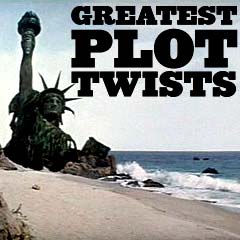
|
Film Spoilers and Surprise Endings L2 |
|
|
||||||||||||||||||||||||||
| Film Title/Year and Plot Twist-Spoiler-Surprise Ending Description | ||||||||||||||||||||||||||
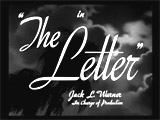
|
In the shocking opening of William Wyler's classic melodramatic film noir of murder and deceit, British plantation owner's wife Leslie Crosbie (Bette Davis) shot neighbor Geoffrey Hammond (David Newell) six times as he staggered out of a tropical bungalow on the grounds of a Malayan rubber plantation. Later when she described the killing and confessed to her lawyer Howard Joyce (James Stephenson), she implied that the murder was justifiable self-defense against a man intent on violating her. However, Joyce's law clerk Ong Chi Seng (Sen Yung) discussed with him a copy of an incriminating letter Leslie had written to Hammond the day she killed him, revealing her real motives (she was desperately in love with Hammond). She wrote that her husband would be away that evening, and pleaded with him to come - implicitly threatening him if he did not. Leslie was blackmailed for $10,000 by Hammond's Eurasian widow (Gale Sondergaard) who had the original letter. A demand was made for a personal apology during the sale (that had emptied her long-suffering husband Robert's (Herbert Marshall) bank account). Mrs. Hammond made a dramatic entrance through a jangling bead curtain, and required that Leslie pick up the letter at her feet.
With the suppression of the letter, Leslie was quickly acquitted in her trial. Later, during a celebratory party, as she was standing on her balcony, she saw a gleaming dagger planted there. Leslie's kind and generous husband, although he knew of her affair, offered to forgive her if she professed her love for him. She admitted her ultimate betrayal in the final line of the film:
In the ending retribution scene, Leslie went to her balcony, where she noticed the dagger was missing. She walked deliberately into her own dark tropical garden, where she saw the outer gate was ajar. Shadows came over her as the moon was covered by clouds. Outside the gate in the darkness, she was confronted by vengeful, retribution-seeking Mrs. Hammond, and another man-servant. She was grabbed and gagged by the man (to stifle her screams), and then stabbed to death by a flashing dagger in Mrs. Hammond's hand. As the two killers were leaving, they were briefly questioned by an officer. When they walked off (to be detained?), Leslie's body was revealed on the ground, as the moonlight illuminated the murder scene. |
 Murder of Hammond by Leslie Crosbie (Bette Davis)  Leslie Crosbie with Lawyer Howard Joyce 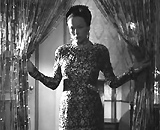 Mrs. Hammond (Gale Sondergaard)  The Dagger  To Husband: "I Still Love the Man I Killed!"  Onto Her Balcony and Into the Garden    Leslie's Stabbed Corpse |
||||||||||||||||||||||||

|
The Life of David Gale (2003)
In this provocative and intense suspense-drama about a death row execution, the brutal rape/murder of anti-capital punishment Death Watch activist Constance Harraway (Laura Linney) was videotaped and ultimately revealed to be a framed set-up. The leukemia-suffering victim had actually engaged in consensual sex with her friend David Gale (Kevin Spacey), sobbing convulsively during the actual act of rape. Her suicide was made to look like she was murdered by Gale. Her hands were tied and she was suffocated with a plastic bag over her head. The plan was to frame title character: fellow activist and intellectual University of Austin philosophy professor David Gale in order to convict, imprison, and ultimately execute him on Death Row (with lethal injection) - he would be made to look like he was a martyr and innocent man in a highly publicized case - in order to prove his death-penalty abolition argument/cause and meet the challenge presented by the governor of Texas. It was revealed that Gale was in on the crime (and he deliberately chose an incompetent defense attorney Braxton Belyeu (Leon Rippy), possibly involved in the deception) - told in stages as a flash-backed story in the few days before his execution to news magazine journalist Bitsey Bloom (Kate Winslet). In the film's epilogue, an uncut version of the videotape (the film's third videotape) labeled "Off the Record" was sent to journalist Bloom from Gale's lawyer with a letter ("...it would be the key to your freedom"). The tape was secretly concealed in a stuffed lamb (Gale's reminder of his son), which Bloom then watched by herself in an AV room. It showed that Harraway's death was not really a suicide, but that Gale had deliberately left his fingerprints on the plastic bag covering Harraway's head, as she already laid naked and dead on the kitchen floor. His unwarranted execution was designed to provide publicity for the cause of those protesting capital punishment. |
 Professor David Gale (Kevin Spacey)  Letter: "It Would Be the Key to Your Freedom"  Videotape of Rape/Murder of Activist Constance Harraway (Laura Linney)  Bitsey Bloom (Kate Winslet) Realizing Deception  The Uncut Video |
||||||||||||||||||||||||

|
The Lincoln Lawyer (2011)
This noirish legal thriller was adapted from Michael Connelly's best-selling book) by director Brad Furman. The "Lincoln Lawyer" was:
The semi-corrupt Haller conducted LA-based business from the back-seat of his chauffeured black, aging Lincoln Continental (license plate - NTGUILTY). The vehicle was driven by Earl (Laurence Mason) - a former client working off his legal fees. Haller had lost his license for a DUI, but had his license returned 3 months earlier, but he still retained his way of doing business. His shifty work, often abetted by lavish amounts of alcohol, was characterized by deal-making, seedy clients (Hell's Angels riding motorcycles in a threatening swarm, druggies, hookers and murderers), and helping to get criminals and other low-lifes freed. Throughout the film, Mick also interacted with his pretty ex-wife Maggie McPherson (Marisa Tomei), a prosecutor who felt he had represented too many "dirtbags." Mick remembered what his father had memorably told him: "There's no client as scary as an innocent man." He had a slight conscience, realizing that if he sent an innocent man to prison, "you're never gonna be able to live with yourself." He was also hounded by Detective Kurlen (Michael Pare) who asked him in an elevator, "How does someone like you sleep at night, with all the scum you represent?" The film opened with a lengthy traveling shot through a courthouse's corridors as Mick spoke to his shady bail bondsmen Val (John Leguizamo) who suggested that the unethical lawyer take note of a potentially-lucrative case. The cocky, drawling shyster lawyer decided to represent:
In the contested case of attempted rape and assault-murder, Mick's client Louis was supported by two individuals with deep pockets:
The manipulative Roulet had deliberately chosen Mick to represent him, so that if any evidence was raised that implicated him in any further crimes, he would be protected because of attorney-client privilege and confidentiality rules. Two versions of the crime against prostitute Regina "Reggie" Campo (Margarita Levieva) were recreated and visualized:
As the investigation progressed, and included the death of Mick's own shaggy long-haired investigator Frank Levin (William H. Macy) - who was shot with Mick's own stolen antigue gun, it became clear that Roulet was guilty of the crime he was charged with. With veiled threats, Roulet also threatened Mick's eight year-old daughter Hayley (Mackenzie Aladjem), and he boldly admitted (off-the-record) to killing a previous murder victim in a similar case. A talkative courtroom trial proceeded between two determined lawyers: Defense Attorney Mick Haller vs. Prosecutor Ted Minton (Josh Lucas), who was assisted by Mick's ex-wife Maggie. There were unreliable witnesses (e.g., jailhouse snitch DJ Corliss (Shea Whigham)), and charges were ultimately dismissed, but the testimony revealed numerous plot twists:
|
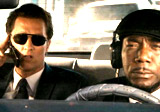 Lawyer Mick with Chauffeur Earl 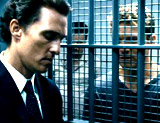 Mick with Client Louis Roulet (Ryan Phillippe)  Defense Attorney Mick Haller (Matthew McConaughey)  Mary Windsor (Frances Fisher) with Son Louis Roulet  Rape Victim Regina "Reggie" Campo (Margarita Levieva)  Earlier Murder of Prostitute Donna Renteria  Murder of Investigator Frank Levin (William H. Macy)   Mrs. Windsor Confronting Mick With Gun |
||||||||||||||||||||||||

|
The Lion King (1994)
In Disney's epic animated musical (considered an interpretation of Shakespeare's Hamlet), Lion Prince Simba was born in Africa to father Mufasa (the king), thus making his Uncle Scar the second in line to the throne. Mufasa's younger brother Scar was jealously angry and envious of his nephew Simba, and plotted with three spotted hyenas (Shenzi, Banzai, and Ed) to kill Mufasa and Prince Simba, take over the Pride Lands, and make himself king. During a wildebeest stampede caused by the hyenas, Mufasa was killed (while rescuing Simba) by Scar and the young cub was led to believe that his father's death was his fault. Young, guilty-feeling, and gullible Simba was encouraged to run away from the kingdom. After years of exile, he grew up. A now grown-up female lioness Nala, with whom he had fallen in love, failed to convince Simba to return home, overthrow usurper Scar (who had become king), and claim the kingdom as his own. After Simba had a vision of Mufasa in a water reflection and then in a large cloud, he was advised to remember who he was, and to return to the kingdom. No longer able to run from his past, Simba came back to the Pride Lands ready to battle Scar for the throne. Their combat began at Pride Rock after Scar tauntingly accused Simba of murder - until Scar admitted, in barely a whisper, that he had killed Mufasa. After calling Scar a "murderer," Simba ordered his uncle from the land of Pride Rock to go into permanent exile when he begged for mercy ("Run away, Scar and never return"), but Scar remained and began fighting. Simba kicked him over the rocks to the hyenas, who attacked and killed Scar for his proposed betrayal ("It was the hyenas who are the real enemy. It was their fault, it was their idea"). The rains were restored to the dried-up Pride Lands, where Simba happily ruled the animal kingdom. Simba and Nala's newborn baby cub was presented to the other animals - thereby continuing the "Circle of Life." |
  The Murder of Mufasa by Scar  Young Simba's Grief  Adult Simba vs. Scar   Simba with His Newborn Cub |
||||||||||||||||||||||||
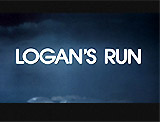
|
Logan's Run (1976)
Michael Anderson's sci-fi action-adventure presented a dystopic view of society in the year 2274, in which inhabitants lived a life of hedonism and pleasure in a domed city (run by a female-voiced super computer). At the age of 30, citizens had to submit to either "renewal" (a peaceful death) or "Carousel" (a gladiatorial battle) - otherwise, they faced having to become a "Runner" to escape. Each inhabitant received a signal to attend a renewal Carousel ceremony, when reaching the age of 30. A "life-clock" crystal embedded at birth in the left hand's palm, would change color and blink red - to signal the "Last Day." Everyone was told that they would be renewed and reborn at the "Carousel" ceremony (attended by an audience cheering "Renewal" in a round amphitheatre), where the white robed participants floated up into the air toward a huge suspended gem - and exploded in a shower of sparks. The film's twist was that the quasi-religious ritual was actually a death ceremony (the participants were zapped like bugs). Logan 5 (Michael York), a cop-like Sandman, was entrusted with capturing Runners who attempted to escape, and trying to reach a place known as "Sanctuary." He learned of a secret underground rebel society (identified by the Egyptian 'ankh' symbol) that aided Runners to escape. And then, as part of his job, Logan 5 was commanded by the female-voiced, omniscient computer system, to become a Runner, find Sanctuary and destroy it. In order to infiltrate the rebel group and complete his mission, Logan 5 was aged 4 years and his life clock began to flash red. He became concerned about restoring his lost 4 years once his assignment was completed, but did not receive a satisfactory answer from the computer. The truth about his society and its practice of after-30 euthanasia policies was revealed to Logan 5 - when he found himself ready to be terminated. He and Jessica 6 (Jenny Agutter) fled the city as fugitives to what they believed was 'Sanctuary.' Once they left the city and were skinny-dipping, they looked at their palms which had turned clear and Logan surmised: "The Life-clocks have no power outside. We're free." 'Sanctuary' was not real - it turned out to be the overgrown ruins of the National Mall in Washington D.C. They stared up at the weed-infested Lincoln Memorial statue. They found the area was inhabited by an elderly white-bearded man (Peter Ustinov) who was living in the US Senate building, where he was surrounded by cats.
By film's end, they returned to their domed city where they attempted to free the entire population into the outer world (through exterior exits) and destroy the city. Logan 5 cried: "You can live! Live! Live and grow old. I've seen it, She's seen it!" and showed his clear left palm, but was met with disbelief. After being captured, Logan was interrogated by the computer, but the truth in Logan's mind caused the computer system to overload and fail. The city's systems ceased and were rocked with explosions, and the exterior exits were opened. The people were released to the outer real world, where they were amazed to see the elderly man with a white beard. |
 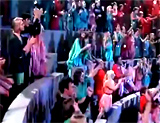  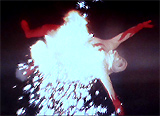 Carousel "Renewal" Ceremony   Sanctuary - the Lincoln Memorial and Washington DC  Elderly Man (Peter Ustinov)  Freedom |
||||||||||||||||||||||||

|
Stanley Kubrick's once-controversial film version of Vladimir Nabokov's 1955 novel began and ended with a connected prologue/epilogue in which literature professor and Humbert Humbert (James Mason), young Lolita's (Sue Lyon) middle-aged stepfather, vengefully shot and murdered TV writer/pedophile Clare Quilty (Peter Sellers) after playing a mad game of ping-pong with him. He was motivated to commit murder for Quilty's duplicity and his part in seducing, running off and abandoning nymphet Lolita. In the murder scene, Quilty fled from the living room toward the curving stairs as Humbert fired again and again. At the top of the grand staircase, Quilty was hit and wounded in the right leg, and he crumpled down. Quilty, dazed and gasping, dragged himself away with his wounded leg to find cover behind a Victorian, Gainsborough-type watercolor painting of an 18th century genteel young woman - the portrait was propped up against the wall in the hallway. Humbert emptied all six rounds of his gun into the portrait, killing Quilty (off-screen) through the painting. At the very end of the main narrative (the in-between story set four years earlier), Humbert (now a broken man) expressed his genuine love and sacrifice for Lolita. He made one final plea to rescue her from her shabby, bland existence in a hovel (with her superficial husband) and return to their own world of the past. When she denied his request, he cried and poignantly reached for over $400 in cash, a check for $2,500, and a mortgage document (from her mother's estate) worth about $10,000. Lolita was astonished and concerned:
Afterwards, Humbert rushed for his car, as she called out from the door with the wad of cash in her hand: "Hey, well listen, let's keep in touch, huh? I'll write to you when we get to Alaska." As he drove away in the fog toward Quilty's mansion, the film returned to the prologue (now epilogue) in which Humbert called out: "Quilty, Quilty!" before the scene faded to black. The ending shot was a second view of the watercolor painting of a young woman with a bullet hole through her face - symbolic of the irrecoverably-marked life of Lolita. The epilogue's title card: "Humbert Humbert died of coronary thrombosis in prison awaiting trial for the murder of Claire Quilty." |
 Prologue: "Do you want to die standing up or sitting down?"  Humbert Humbert (James Mason) With Gun 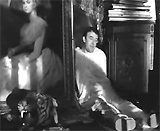 Wounded Clare Quilty (Peter Sellers) Dragging Himself Behind Painting  Quilty Murdered Behind Portrait  Humbert with Married Lolita - Offering Her Cash  Epilogue |
||||||||||||||||||||||||

|
Lone Star (1996)
Writer/director John Sayles' murder mystery explored interpersonal and interracial tensions and dark secrets in Rio County, Texas (a fictional locale) - including the investigation of a past murder. The tagline was:
It ended with a twist revelation regarding the rekindled relationship between a loving couple - who originally dated in high-school:
Sheriff Deeds and Pilar Cruz were actually half-brother and sister. When earlier they were teenaged high-school sweethearts (Tay Strathairn as young Sam and Vanessa Martinez as young Pilar), their relationship was forbidden not because of racial enmity or prejudice, but because of a secret love affair between:
The film ended with Pilar and Sam meeting at a deserted drive-in where they used to go as teenagers. They sat on the hood of his car. After Sam's investigation, he revealed that she was 'fathered' by "Buddy" (not Eladio) with Mercedes - and therefore, Pilar and Sam were half-siblings to each other.
She delivered a shocking last line about digging up the past, indicating that they would continue their semi-incestuous loving relationship:
[Note: The film that played at the drive-in when they were teenagers hinted at Pilar's mixed parentage of Hispanic/Mexican and Anglo: Black Mama, White Mama (1972).] |
 Sheriff Charlie Wade (Kris Kristofferson)  The Murder of Eladio Cruz by Sheriff Wade  Sheriff "Buddy" Deeds (Matthew McConaughey)  Sheriff Sam Deeds (Chris Cooper)  Pilar Cruz (Elizabeth Pena)  Revelations from Sam to Pilar at the Old Drive-In  Old Photo: "Buddy" Deeds and Pilar's Mother Mercedes  Sheriff Sam Deeds with Pilar Cruz - Half-Siblings |
||||||||||||||||||||||||

|
Looking for Mr. Goodbar (1977)
Richard Brooks' sexually frank and cautionary adaptation of Judith Rossner's 1975 fictional best-seller descended into the carnal depths of New York's singles bars during the height of the sexual revolution. It ended with an inevitable (although still shocking and chilling) fate for promiscuous, sexually-awakened, self-destructive Catholic-raised school teacher of deaf-mute children Theresa Dunn (Diane Keaton). Theresa was a predatory, bar-hopping female cruiser searching for the perfect one-night-stand ("Mr. Goodbar") as a way to escape her dull and mundane life. She found herself threatened by possessive and jealous lover Tony (Richard Gere). She ended up dead - a victim of casual sex and 'free love' in the late 70s. Her graphic and brutal murder was committed not by Tony, but by enraged one night-stand lover Gary White (Tom Berenger). She had picked Gary up at a bar on New Years' Eve, and she brought him home to her apartment. He turned out to be an unstable, closeted homosexual. After they began making out on her bed, he claimed he couldn't get an erection, and she tried to be reassuring: "Maybe, maybe it's me. Whatever, it's not your fault. It happens." He responded: "Goddamn women, all you gotta do is lay there. Guys gotta do all the work. (She laughed) You think that's funny!" She joked further, not realizing that she was insulting his manhood: "Well, I think it's a helluva way to start the New Year." When she demanded that he leave, and asked: "What are you trying to prove?", he went ballistic:
A blue strobe light blinked on/off while he strangled, smothered and stabbed her, and also raped her after finding himself aroused. |
 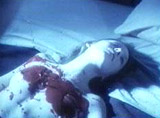 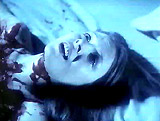 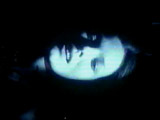 The Murder of Theresa Dunn (Diane Keaton) |
||||||||||||||||||||||||

|
Looper (2012)
This was a mind-bending, intelligent sci-fi action thriller by talented writer-director Rian Johnson. Two of the earliest characters introduced in the film were "Loopers" (or contract killers) - the film's title:
Joe lived in the year 2044 in the burned-out, socially-decayed, dystopic metropolis of Kansas City. He was a low-level, yet specialized hitman (or "looper"). Both Joe and Seth worked for crime boss Abe (Jeff Daniels) in a Kansas syndicate. Abe had been sent back from the future by the mob to manage or run the loopers. He arranged and hired a contract killer (looper) to assassinate each of the mob's selected victims at a pre-arranged drop-off point - a remote corn/wheat field. Although time travel was yet to be invented in 30 years (in the year 2074), it was immediately outlawed. However, it had been appropriated and used by criminal gangsters, such as a controlling mastermind mob boss named Rainmaker 30 years into the future (2074), to execute enemies and leave no trace. It was a foolproof method - targeted enemies to be eliminated were sent back from 2074 to the present year of 2044, to be disposed of (with no trace left, such as a murdered corpse).
Because of his fancy and lucrative lifestyle and career, young hedonistic Joe was able to afford fine retro clothes, a classic red Miata, and a fancy hooker/showgirl Suzie (Piper Perabo). She worked as a can-can dancer at Abe's nightclub "La Belle Aurore." After a naked encounter together, she told him that their relationship didn't go further than "services rendered." The main plot was that Joe found himself in a twisting situation where his next target was himself - 30 years older Old Joe (Bruce Willis). Old Joe had been living a good life in the future - in Shanghai, China with an unnamed wife (Xu Qing). He had traveled back in time to the year 2044 - to find and kill the monstrous Rainmaker as a young kid, to change the future, save himself from being eliminated, and retain his great lifestyle. According to Old Joe's sources, someone known only as the Rainmaker had called for all the retired loopers to start having their loops closed. The younger Joe was in hiding from Abe (his own mob boss) at the remote Kansas farmhouse of devoted single-mother Sara Rollins (Emily Blunt) with her son Cid (Pierce Gagnon) (who was revealed to have enormous telekinetic powers). Young Joe suspected that Cid might be one of the children Old Joe thought was the Rainmaker, so he was there to protect Sara and her child. The mind-bending conclusion revealed that Cid was the Rainmaker. Young Joe realized that if Old Joe killed Sara, Cid's destiny would be disastrous - he would be filled with anger and hatred, and would grow up to become the evil, vengeful Rainmaker. As Sara shielded her son Cid from Old Joe's line of fire, young Joe had a sudden realization - something he knew he could alter immediately:
To remedy and avert the situation, younger Joe saw that he was too far away to prevent the tragedy of Sara's death, so he shot himself to death in the heart to erase Old Joe's life, just as Old Joe was about to shoot Cid's mother. Old Joe immediately vanished in front of Sara. |
 Old Joe (Bruce Willis)  Sara Rollins (Emily Blunt) 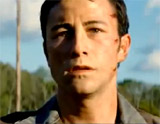 Young Joe Simmons (Joseph Gordon-Levitt)  Joe with Suzie (Piper Perabo) 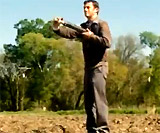 Young Joe's Sacrificial Suicide  Old Joe Disappeared in Front of Sara |
||||||||||||||||||||||||
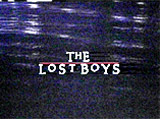
|
The Lost Boys (1987)
Director Joel Schumacher's R-rated teen horror film was titled to reference "the lost boys" in J.M. Barrie's Peter Pan and Neverland stories, and began with the premise that Peter Pan was a vampire. Shot in the northern California coastal town of Santa Cruz, it showcased the talents of many young stars of the late 80s, including Kiefer Sutherland, Jason Patric, Corey Haim, Jami Gertz, and Corey Feldman, and contained a pop music soundtrack. There were two direct-to-DVD sequels (with more sex and violence) in a trilogy of films: Lost Boys: The Tribe (2008) and Lost Boys: The Thirst (2010) - Corey Feldman was the only actor in the original film to return in both sequels. The cleverly-marketed, influential production was a hybrid teen film and comedy horror film, evidenced by its tagline:
The stylishly-filmed, over-the-top story opened with the Emerson family moving from Phoenix to the northern California coastal town of Santa Carla (fictional) with a beachfront boardwalk and amusement park. They joined up with the financially-strapped, single mom's eccentric father - Grandpa (Barnard Hughes), a taxidermist:
The first hints that things were awry in the town was that its welcoming entry sign war marked with graffiti: "Murder Capital of the World." There were numerous "Missing Child" posters in town and the boardwalk area, and Grandpa mentioned: "There are some bad elements around here." An unknown entity killed a security guard in the boardwalk's parking lot and a couple in their car (after removing the car's top). The members of the Emerson family soon found work or companionship:
And then Michael, to get close to Star, visited the gang's sea-cliff headquarters (a cave - the remnants of a sunken resort hotel under Hudson's Bluff that had fallen into a fault crack in the 1906 earthquake). David had Michael believing that the Chinese food they were consuming was actually made up of live maggots and worms. To be initiated into their secret society, Michael accepted the challenge to drink a bottle of blood, David's blood ("Drink some of this, Michael. Be one of us"). Sam knew immediately that his older brother Michael had become a "creature of the night...a goddamn s--t-sucking vampire" - not casting a reflection in a mirror. The Frog Brothers confirmed the diagnosis. After Lucy was attacked at video-store owner Max's house by his fierce, suspiciously-named dog Thorn ("a daytime protector, a guardian"), possibly an example of the "Hounds of Hell," Sam visited his Frog brother friends who stated: "Santa Carla has become a haven for the undead." From comic books, Sam realized that Michael was only a "half-vampire" because he had not sucked anyone's blood, and his condition could be reversed if the "head-vampire" was killed. The major plot twists (or surprise revelations) were forthcoming:
The film ended with a punchline from Grandpa as he went to the refrigerator for a bottle of root-beer, casually revealing that he had always known about the vampires:
|
 David (Kiefer Sutherland)  Michael (Jason Patric) and Sam (Corey Haim)  Star (Jami Gertz) with David  Vampire Comic-book  David's Vampire self  Michael: A Half-Vampire  Death of David   Head Vampire Max (Edward Herrmann)  Max's Impalement and Death  Michael Reverting to Normal  Grandpa Drinking Root-Beer |
||||||||||||||||||||||||

|
Lost Highway (1997)
This intriguing, non-linear David Lynch psychological thriller, with film-noirish characteristics, was extremely enigmatic. The entire film could be interpreted as a subconscious, psychotic dream, deranged fantasy, or imagined memory (or even a kind of purgatory or hell) of the main protagonist, who was accused of murder (and possibly about to be executed in prison (by the electric chair)) after killing his unfaithful wife. It was possible that the prison was only metaphoric, and that he was imprisoned in his own fractured delusions during interrogations. In the film's opening, a mysterious voice (over his home's intercom system) cryptically told wealthy LA tenor saxophonist/ jazz musician Fred Madison (Bill Pullman) a meaningless statement at the time:
During part of the film, Fred's life was bizarrely linked or intertwined with many others. In prison, he morphed or was reborn into the 'hallucinated' character of Pete Dayton, after being convicted of murdering his wife Renee (Patricia Arquette) and held on death-row for execution. When Pete returned to his auto mechanic garage job, he attracted the attention of mobster thug "Mr. Eddy" (Robert Loggia) for car repairs, and found himself having passionate feelings for the mobster's mistress Alice (resembling Fred's wife Renee) - Pete/Fred was soon having illicit sex with her, to compensate for losing his wife earlier. When Pete was drawn into the schemes of Alice and Mr. Eddy, his plan was to rob her porn producer friend Andy (Michael Massee) and then run away with Alice, but the theft was bungled and Andy was accidentally killed. Alice told Pete that "Mr. Eddy" was actually a porno producer named Dick Laurent, and she was forced to perform in his skin flicks. When the two laid naked together in the desert and were lit by the car's headlights while making love, he told her: "I want you," and she whispered in his ear: "You'll never have me."
The plot became even more complex when Pete transformed back into his original identity as Fred, and Alice returned to being Renee, and the plot circled back upon itself. Fred's delusion broke down and he found himself back in reality and under interrogation for his wife's murder. By the film's conclusion, the Mystery Man (standing next to Fred) shot and killed porn mogul Mr. Eddy (Dick Laurent) in the desert, for having sex with Renee. Just before the murder, the Mystery Man played videotape proof of the affair to Mr. Eddy. The final few lines of dialogue were between the two detectives: Ed (Louis Eppolito) and Al (John Roselius), who were looking over the crime scene where Pete killed burglarized victim and Renee's porn co-star and producer Andy in his luxurious home, with the help of a scheming Alice. The officers noticed a photograph of Mr. Eddy (Dick Laurent), Renee, and Andy (earlier in the film, Alice was also in the same photo):
After returning from the desert in Mr. Eddy's car, Fred arrived at the front of his home and told himself at his house's intercom callbox that Dick Laurent was, in fact, dead. When the two detectives arrived at the house and saw him, they pursued after him - a chase into the desert, down a 'lost highway'. |
The Two Photographs (With and Without Alice) |
||||||||||||||||||||||||

|
The Lovely Bones (2009)
Producer/director Peter Jackson's gripping, difficult-to-view and emotional supernatural drama, with some references to Ghost (1990) and his own Heavenly Creatures (1994), was based upon Alice Sebold's 2002 best-selling novel (her second) of the same name. It told of a family tragedy that occurred in 1973 in Norristown, Pennsylvania, involving:
The slightly-preachy, misfiring film was actually told from her perspective within the afterlife, as a dead and omniscient narrator and observer - symbolized by the opening scene of a young Susie peering into a snowglobe where a penguin was trapped:
Abruptly finding herself narrating the film from the hereafter following the film's early plot revelation, she had just been viciously raped (off-screen) and murdered by:
Just before Susie's murder, in a cautionary sequence, the adolescent, sexually-curious Susie was coming of age and just about to experience her first kiss next to her school locker, delivered by her older senior schoolmate crush Ray Singh (Reece Ritchie). But then Principal Caden (Thomas McCarthy) interrupted them - irate over the "obscene," anatomically-correct nude female that her classmate friend Ruth Connors (Carolyn Dando), a "strange, other-worldly girl" had sketched. On her way home in the middle of a cornfield behind the school, the predatory pedophile and child molester had lured Susie through a trap door and down a ladder into an underground dugout or "clubhouse":
The film went on to portray how she dealt with understanding her own death in another afterlife dimension - the "in-between" located between heaven and Earth:
It was visualized with imaginative CGI special effects that paid homage to What Dreams May Come (1998), as she watched her grieving family from above. She was counseled by her own afterlife guide-friend Holly Golightly (Nikki SooHoo), with a borrowed name - who advised her to proceed onward to Heaven, rather than looking back and not letting go: "You're not supposed to look back. You're supposed to keep going." Holly added: "This isn't heaven. You're not there yet." Susie admitted she wasn't ready for heaven, and had to go home first to seek retribution - to help provide clues that would solve her case and lead to the apprehension of her murderer: "But I wasn't looking beyond yet. I was still looking back." Susie saw evidence of the killer's previous six female victims over many years (from 1960 to 1971), including:
Susie, the 7th victim, saw that Harvey had stuffed her own body in a blood-soaked bag into a safe in his home's muddy basement. Susie's younger teenaged sister Lindsey (Rose McIver) - now grown up and the class of 1977-78's senior class valedictorian, was Harvey's next target when the need rose in him to kill again. The suspicious Lindsey, determined to find evidence to implicate her neighbor, snuck into Harvey's house in a highly-suspenseful scene. After kicking in a window in the basement and entering, she went upstairs where she found a notebook under the bedroom floorboard containing notations about the murdered Susie Salmon, a sketch of the location of the den in the cornfield and its dimensions, and a picture of Susie and a lock of her hair. Lindsey barely escaped (with the notebook) from Harvey who had returned home, after fleeing through an upstairs bedroom window and racing away. Harvey fled town, taking with him the heavy safe to dispose of it in the Connors' sinkhole dump site. Time had passed, and Susie saw that her family was healing after her long absence, as she reflected:
The film concluded with a strange coda of divine retribution. In a family restaurant's parking lot, as Harvey spoke to a young girl smoking a cigarette and volunteered to give her a ride, a magical white glow caused a large icicle to fall from an overhead branch. It hit him on the shoulder, causing him to lose his balance on the ice and fall backwards over a cliff ledge to his death. Susie finally was ready to enter Heaven, with her last voice-over, as her mother entered her bedroom and spoke the words: "I love you, Susie":
|
 Young Susie With SnowGlobe  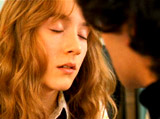 Susie Salmon (Saoirse Ronan) - Coming of Age  School Principal Caden  Mr. Harvey (Stanley Tucci)  Susie Lured to Clubhouse    Haunting Images   In the Afterlife   The Next Target; Lindsey (Rose McIver) Fleeing from Mr. Harvey  Divine Retribution for Mr. Harvey |
||||||||||||||||||||||||

|
Lucky Number Slevin (2006)
This semi-hard-boiled, clever pulp thriller from director Paul McGuigan, a visually-stylistic caper-crime film basically, was filled with numerous convoluted twists and turns and secrets underlying the action, two-named characters, and a slightly cheating ending/revelation. Its overall atmosphere was an earnest and witty, yet derivative, combination of Pulp Fiction (1994) and The Usual Suspects (1995). The needlessly tangled and contrived, overly-complex plot was only revealed and explained much later in the proceedings. The taglines were:
The brief prologue (during the opening credits) was completely confusing until explained later. There were two bloody crime scenes, set in the present day: In both cases, information had been stolen from the two rival bookies - the records of their transactions. [Later, it was revealed that found in both sets of cross-referenced books was the name of indebted gambler Nick Fisher, who owed money to two big-time feuding rival crooks.] The film really began, in a non-descript, antiseptic waiting room of a depot, where traveler Nick Fisher (Sam Jaeger) was approached by an out-of-town wheelchair-bound stranger (Bruce Willis) who claimed his name was Smith. He said he was in town because of a "Kansas City Shuffle." He explained the hoodwink:
He said it had been over 20 years in the making, and had required a lot of planning and involved a lot of people. He related a backstory from 1979, told with lengthy flashbacks, about a fixed horse-race that led to failed bets, debt, and murders:
At the Aqueduct Racetrack in New York in 1979, a horse named Lucky Number Slevin was injected by Doc (Nicholas Rice) with a drug to insure victory ("a sure thing"). The news about the predicted winning horse (Lucky Number Slevin) was relayed from person to person:
Max bet $20 grand (borrowed from the mob's Boss) on the drugged horse with the Boss' bookie Roth (Danny Aiello). He then went to the track to watch the 10th race. Max's young 7 year-old son Henry (Oliver Davis) remained in the parked car. Unexpectedly with bad luck, the horse fell during the final stretch and Max lost the bet. In the parking lot when he returned there, his car was missing, and Max was grabbed by two thugs. Max's bookie Roth was murdered, Max was asphyxiated with a plastic bag by the Boss' two thugs, and his wife was also killed. An unidentified hitman held a gun to the back of Henry's head. The retaliatory Boss didn't like anyone betting on a fixed horse-race, losing, and then owing thousands of dollars. Smith claimed that his story was the "inciting incident" or "the catalyst" - and then tricked Nick. He disappeared from his wheelchair, told Nick from behind that "This is a Kansas City Shuffle" and snapped Nick's neck. Nick's body was wheeled into the back of a truck. Smith said that Nick's body was required for the present-day scam: "You can't have a Kansas City Shuffle without a body." What was Smith's association with the aftermath of the failed fixed horse-race, and how was indebted gambler Nick related? In the present day, 'Slevin' Kelevra (Josh Hartnett) (not yet revealed to be the grown-up Henry) was visiting the NYC apartment of his alleged deadbeat, gambling 'friend' Nick Fisher. He was claiming he had suffered a broken nose after being mugged (and now had no proof of identity). He also alleged that he had just lost his job, found his apartment was condemned due to termites, and had broken up with his unfaithful girlfriend Kelly Perkins (Jennifer Miller).
Then, there were two cases of mistaken identity - Slevin was twice seized in Nick Fisher's apartment, and believed to be the debt-ridden gambler by both opposing mobster groups (led by The Boss and the Rabbi).
Nick owed $96K to the Boss, and $33K to the Rabbi. The two criminal groups were engaged in lex talionis ("the law of retaliation"), and had both hired Smith/Goodkat. Hitman Smith/Goodkat agreed to both kill the Fairy (for the Boss) and protect The Fairy (for the Rabbi) - on the condition that they call in Nick Fisher's debts. In both cases of mistaken identity when 'Slevin' (believed to be Nick) was seized, the crime bosses called in Nick's debts:
Also helping Slevin was Nick's chirpy, chatty and inquisitive neighbor Lindsey (Lucy Liu), a morgue pathologist/coroner who was interested in sorting things out. Sleuthing, she took a cellphone picture of Smith in a hotel elevator to try and identify him.
All that was left was for the deadly setup to play out:
|
 First Murder - In Parking Garage  Second Murder - in Bookie's Office Important Flashback:   Hit-man Smith/Goodkat (Bruce Willis) Hesitating to Kill Young Henry  Out-of-Town Stranger Smith (Bruce Willis)  Nick Fisher's Neck Snapped by Smith  Max (Scott Gibson) with Son Henry at Racetrack  'Slevin' Kelevra (Josh Hartnett) (Young Henry Grown Up)  Slevin with Nick's Neighbor Lindsey (Lucy Liu)  'Slevin's' Cheating Girlfriend Kelly  The Boss (Morgan Freeman)  Picture of The Boss With His Son, Who Was Murdered by the Rabbi's Sniper  The Rabbi (Sir Ben Kingsley)  Hitman Goodkat  Detective Brikowski (Stanley Tucci)  Fisher's Body Put in Yitzchok's Apartment  The Boss and Rabbi Bound Back to Back  Lindsey Shot - But Saved With Vest  Slevin with the Two Opposing Criminal Leaders 
Slevin Murdering Detective Brikowski |
||||||||||||||||||||||||